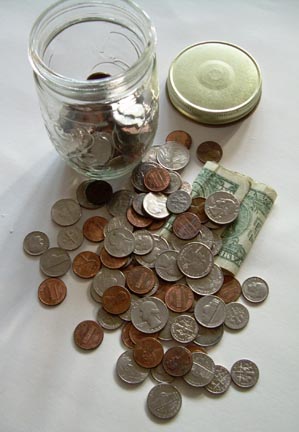
Money and
Real-World Math
Money is great for learning and reinforcing basic math concepts. Because money is based on the decimal system (10 pennies = 1 dime, 100 cents = $1), one can easily use it to teach place.
Money is also a great example of real-world math, and one that children can understand. They concept of saving and (especially) spending money is easy to grasp.
As with playing cards and dice, children are also fascinated by coins and bills as objects. They like counting coins, piling them up, trading in pennies for nickles or quarters for dollars, and so on. My son would always insist on picking the shiny, new-looking coins and tossing the grubby ones back into the jar.
Real Money vs. Play Money
When I began shopping around for play money, I was shocked at how much it cost. I thought, "They want just as much in real money as they will give me in plastic money!"
This led to an idea, namely to use real money rather than play money in my games. So I went to the bank and got $5 in quarters, $5 in dimes, $3 in nickles, and $.50 in pennies. I
keep this in a "money jar" (pictured above right). Every now and then, I also throw random piles of left-over change into the jar. This gives us more than enough coins - and a few bills - for our money-based games, such as "Cha Ching! Salesman of the Week." And, once my son is too old to play math money games, we won't have piles of play money sitting around gathering dust. We can have our math money and spend it, too!
Sometimes, though, using real money is not feasible. For instance, "King Richard's Ransom" calls for large sums, and I'm not about to stuff hundred-dollar bills into the money jar! I got my hands on some Euro play money (pictured at left), which European banks were giving out for free when the Euro was first being introduced. This has the added bonus of looking nicely exotic.
If I didn't have this stash, I'd either make my own play money or use some from other board games like "Monopoly" or "Axis and Allies." Of course, you can always just go out and buy some play money, as well.
Kinds of Money-Math
The most common uses for money are in teaching addition and subtraction. A simple addition problem might be, "If Bob wants to buy one book that costs $2 and another book that costs $3, how much money does he need altogether?"; a more complex problem that uses subtraction might ask, "Mike has $7.50, and he wants to buy a toy car for $2.89, so how much will he have left over?" It is also easy to use money in teaching skip-counting and multiplication, especially for the 5 and 10 facts.
Another application is in illustrating the concept of equivalent values. I have enjoyed watching my son's understanding of this develop. When I asked him to count out a certain amount of money - say, 37 cents - he would at first pick three dimes and seven pennies (3 tens and 7 ones). Later on, he took three dimes, one nickle, and two pennies, and eventually he just picked out one quarter, one dime, and two pennies.
As mentioned above, money is also good for teaching place value and the decimal system. In most curricula, decimals are not taught until the fifth or sixth grade, but it doesn't hurt to introduce that little "dot" early on. Kids may not understand what it means, exactly, but at least they'll be familiar with one very common use for it.